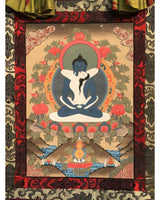
Samantabhara Buddha Thangka | Traditional Buddhist Art | Tibetan Hand Painting

100% AUTHENTIC

HANDMADE

FREE SHIPPING
Samantabhadra Traditional Thangka
About Our Thangka :
Representing Dharmakaya-the truth body of enlightenment, Samantabhadra thangka painting for your practice. In this traditional thangka painting, we can see the primordial Buddha, Samantabhadra in unison with his consort in Vajra posture.
Introduction To Samantabhadra :
The deep blue Primal Buddha and his pure white wisdom consort represent together the blissful essence of the truth body of all Buddhas, the most profound, ultimate reality of the universe, unwittingly experienced by all beings but consciously known only by the enlightened. For the unenlightened to use icons such as this to find faith in the underlying and overwhelming goodness of reality itself is considered essential for their evolutionary and spiritual well-being.
Samantabhadra is a personification of the extremely subtle wisdom, great bliss mind of all beings and all Buddhas, the primal awareness of the universe. He is in union with the Great Mother, Samantabhadri, who is the clear light of the void indivisible from enlightened awareness. Samantabhadra Father-Mother thus represents the Great Perfection vision of reality, the idea that the fundamental nature of the universe is pure bliss and goodness, total positive energy of joy and of freedom from suffering if beings only turn away from their delusive habits long enough to recognize this very substance of their being.
------------------------------------------------------------------
Size with Brocade: 25" / 63 cm (width) x 35"/ 89 cm (height)
Canvas Size : 10" / 25 cm (width) x 15"/ 38 cm (height)
Materials: Cotton Canvas, Acrylic Colors, Genuine 24K Gold
------------------------------------------------------------------
THIS THANGKA IS HAND-PAINTED IN THE TRADITIONAL STYLE AND THE QUALITY IS HIGH
What is the significance Power duty of Samantabhadra?
- To request the Buddhas to remain in the world.
- To follow the teaching of the Buddhas at all times.
- To accommodate and benefit all living beings.
- To transfer all merits and virtues to benefit all beings.
Shipping & Returns
We ship worldwide. Orders dispatch in 2–3 business days. International delivery typically arrives in 4–10 business days via DHL Express, depending on destination and carrier conditions. All items ship free globally.
Returns are accepted within 14 days of delivery. Products must be returned in original condition for a refund to be issued once received and inspected. Terms and conditions apply.











